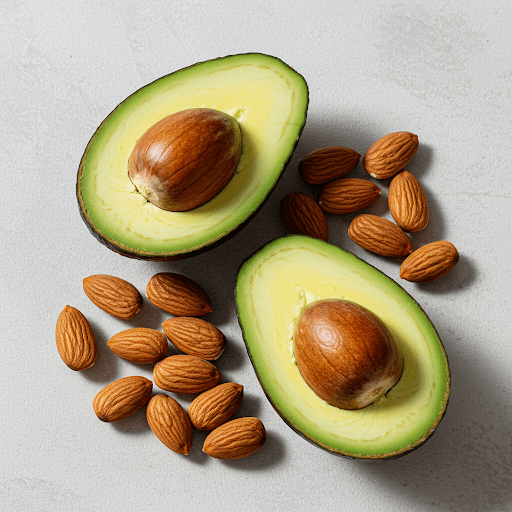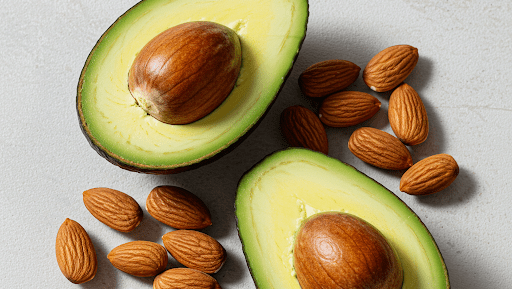Good Fats for Diabetes: The Friendly Fats You Need to Know
Today let’s dive into good fats for diabetes. When you have diabetes, you hear a lot about what you can’t eat. But guess what? There are some really good foods out there, and some of them have something called “fat.”
Now, I know what you might be thinking: “Fat? Isn’t that bad for you?” Well, it’s like saying all dogs are the same – there are big dogs, small dogs, fluffy dogs, and short-haired dogs. It’s the same with fats! Some fats are not so great, but others are like superheroes for your body, especially when you have diabetes.
For a long time, people with diabetes were told to really cut back on all kinds of fat. But scientists have learned more, and now we know that some fats are actually your friends! These friendly fats can help your blood sugar and even keep your heart healthy. Let’s dive into the world of good fats!
Table of Contents
The “Bad” Guys and the “Good” Guys of Fat
Think of fats like a team. On the “not-so-great” side, we have:
- Saturated Fats: These are often solid at room temperature, like the fat in butter and some meats. You don’t have to totally avoid them, but it’s a good idea to not eat too much.
- Trans Fats: These are often found in processed foods like some baked goods and fried snacks. They are like the villains of the fat world, and it’s best to stay away from them as much as possible.
Now, let’s meet the superheroes – the “good” fats:
- Monounsaturated Fats (MUFAs): These fats are usually liquid at room temperature. Examples include olive oil or the creamy part of an avocado.
- Polyunsaturated Fats (PUFAs): These are also liquid at room temperature. This group includes important fats like Omega-3s and Omega-6s, which you can find in fish like salmon and in walnuts.
Why Good Fats are Great for Diabetes
So, why are these good fats so helpful when you have diabetes? Here’s the scoop:
- Good Fats Help Your Body Use Insulin Better: Insulin is like a key that opens the door for glucose to get into your cells for energy. Some studies show that Monounsaturated Fats can help your body use that key more effectively. This is called “insulin sensitivity.”
- Study Example: One study looked at people who ate a diet with lots of Monounsaturated Fats , like olive oil. The study found that their bodies got better at using insulin.
- Good Fats Are Great For Heart Health: People with diabetes have a higher chance of developing heart problems. Good fats, especially Monounsaturated Fats and Omega-3s, can help keep your heart healthy. They do so by improving cholesterol levels and blood pressure.
- Study Example: Another study compared people who ate a diet high in Monounsaturated Fats to those who ate other kinds of diets. The people who ate more MUFAs often had healthier levels of “bad” cholesterol.
- Good Fats Help Fight Inflammation: Sometimes, when your body has diabetes, it can have more inflammation (like when you get a cut and it gets red and swollen inside). Good fats, especially Omega-3s, can help calm down this inflammation.
- Good Fats Help You Feel Full: Fats help you feel full after you eat. This can be helpful for managing your weight, which is often a good thing when you have type 2 diabetes.
- Good Fats Help Regulate Your Blood Sugar: Unlike sugary foods, fats don’t make your blood sugar spike quickly. In fact, they can help slow down how fast sugar gets into your blood after a meal.
- Study Example: One study found that when people with diabetes ate more Monounsaturated Fats, their blood sugar levels were more stable.

Top 10 Fats For Diabetes
Table 1 shows top 10 healthy fats that can be beneficial for individuals with diabetes. We’ve also included general information about their fat content and impact on glucose. Keep in mind that these fats don’t significantly raise blood glucose. However, the overall carbohydrate content of the food they are found in (like nuts or seeds) will affect blood sugar levels. Therefore, portion control is always important.
| # | Food Item | Type of Fat Primarily | Approximate Fat Content (per serving) | Approximate Glucose Impact | Notes |
| 1 | Avocado | Monounsaturated | 15-20g (per medium avocado) | Very low glucose impact due to high fiber and low carbohydrate content. May help improve insulin sensitivity. | Versatile; can be added to salads, sandwiches, or eaten as a snack. |
| 2 | Olive Oil (Extra Virgin) | Monounsaturated | 14g (per tablespoon) | Very low glucose impact. May improve insulin sensitivity and heart health. | Use for salad dressings, drizzling over cooked vegetables, or light sautéing. Avoid high-heat cooking which can damage its beneficial compounds. |
| 3 | Almonds | Monounsaturated, Polyunsaturated | 14g (per ounce, about 23 nuts) | Low to moderate glucose impact depending on the quantity consumed due to carbohydrate and fiber content. Good source of magnesium. Portion control is key. | Enjoy as a snack, add to salads or yogurt. Choose unsalted varieties. |
| 4 | Walnuts | Polyunsaturated (Omega-3), Monounsaturated | 18g (per ounce, about 14 halves) | Low to moderate glucose impact due to carbohydrate and fiber content. Excellent source of plant-based Omega-3 fatty acids. Portion control is important. | Great as a snack or added to oatmeal or baked goods. |
| 5 | Fatty Fish (Salmon, Mackerel, Sardines) | Polyunsaturated (Omega-3) | Varies depending on type and serving size (e.g., ~12g per 3oz cooked salmon) | Very low glucose impact. Rich in EPA and DHA, types of Omega-3s beneficial for heart health and reducing inflammation. | Aim for 2-3 servings per week. Choose wild-caught when possible. |
| 6 | Chia Seeds | Polyunsaturated (Omega-3), Monounsaturated | 11g (per ounce, about 2 tablespoons) | Low glucose impact due to high fiber content. Can help stabilize blood sugar levels. | Can be added to smoothies, yogurt, or made into chia seed pudding. |
| 7 | Flaxseeds | Polyunsaturated (Omega-3), Monounsaturated | 12g (per ounce, about 2 tablespoons) | Low glucose impact due to high fiber content. Lignans in flaxseeds may also have health benefits. | Grind flaxseeds for better absorption of nutrients. Add to smoothies, oatmeal, or baked goods. |
| 8 | Peanut Butter (Natural) | Monounsaturated, Polyunsaturated | 16g (per 2 tablespoons) | Low to moderate glucose impact depending on added sugars. Choose natural varieties with no added sugar. Moderate portion due to calorie density. | Enjoy on whole-wheat toast, with celery sticks, or as a dip for apple slices. |
| 9 | Canola Oil | Monounsaturated, Polyunsaturated | 14g (per tablespoon) | Very low glucose impact. A neutral-flavored oil suitable for various cooking methods. | Use in cooking and baking. |
| 10 | Olives | Monounsaturated | 10-15g (per ounce, about 10 large olives) | Very low glucose impact. Good source of antioxidants. Be mindful of sodium content, especially in processed olives. | Enjoy as a snack or add to salads and other dishes. |
Important Considerations:
- Portion Control: Even healthy fats are calorie-dense, so it’s important to consume them in moderation, especially if weight management is a goal.
- Overall Diet: These healthy fats are most beneficial when part of a balanced diet that is appropriate for diabetes management, including controlled portions of carbohydrates and adequate protein and fiber.
- Individual Responses: Blood glucose responses can vary from person to person. It’s always a good idea to monitor your blood sugar levels and work with your healthcare team or a registered dietitian to determine the best dietary plan for you.
- Added Ingredients: Be mindful of added sugars, salt, or unhealthy fats in processed versions of these foods (e.g., sweetened nut butters, heavily salted nuts, fried fish). Opt for natural and minimally processed options.
This table provides general information. Always consult with your doctor or a registered dietitian for personalized dietary advice based on your individual health needs and diabetes management plan.

How to Sneak in These Good Fats
Okay, so how do you actually eat more of these good fats? It’s easier than you think!
- Cooking with Olive Oil: Instead of butter or other oils, try using olive oil when you cook.
- Avocado Power: Add slices of avocado to your sandwiches or salads. They’re creamy and delicious!
- Nutty Snacks: Grab a small handful of almonds, walnuts, or peanuts for a snack. Just remember, nuts have calories, so don’t eat too many at once.
- Fish for Dinner: Try to eat fatty fish like salmon or tuna a couple of times a week. They are packed with Omega-3s.
- Sprinkle Some Seeds: Add flaxseeds or chia seeds to your yogurt or oatmeal.13
- Homemade Salad Dressing: Make your own salad dressing with olive oil and vinegar.14
Common Questions About Fats and Diabetes
- Can I eat nuts if I have diabetes? Yes, in small amounts! Nuts are a great source of good fats, fiber, and protein. Just watch your portions.
- Is olive oil really good for me? Yes! Olive oil is full of Mono Unsaturated Fatty Acids, which are great for your heart and blood sugar.
- How much fat should I eat each day? It’s different for everyone. It’s best to talk to your doctor or a dietitian to figure out what’s right for you. They will also focus on the type of fat.
- Is all fat in fish good? Fatty fish like salmon have lots of healthy Omega-3 fats. Other fish are good too, but those are the superstars for Omega-3s.
- Are all plant-based oils healthy? Most, like olive oil, and sunflower oil, have good unsaturated fats. But some, like coconut oil and palm oil, are higher in saturated fat, so use them in smaller amounts.
- Do I need to avoid all high-fat foods? No! Focus on eating more foods with healthy fats and less of the unhealthy kinds. Portion control is also important.

The Bottom Line: Good Fats are Your Friends!
Having diabetes doesn’t mean you have to be afraid of all fats. In fact, including more monounsaturated and polyunsaturated fats in your diet can be really good for you. They can help your body use insulin better, keep your heart healthy, and even help manage your blood sugar. So, embrace the good fats as part of a balanced and healthy eating plan! Just remember to talk to your doctor or a registered dietitian to get advice that’s just right for you.
